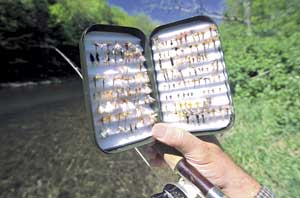
The most common question asked by most novice fly anglers is: “How do you decide what fly to use?
The biggest misconception that many non-fly anglers have about the sport is that fly choice is an elusive, highly scientific process that only enlightened masters truly understand. It’s an image, unfortunately, that too many fly anglers go out of their way not to dispel. After all, it feels pretty self-righteous to be a part of a little-understood, exclusive club.
The reality of choosing the right fly pattern, however, is much closer to “Well, this is as good as anything else” than to the perceived advanced calculus people are led to believe.
From my experience, the ability to relax and comfortably choose a fly is what separates the novice from the experienced angler.
Volumes have been written about aquatic insects and the fly patterns that imitate them. Although there are times when we need to resort to this scientific approach of precisely matching color, size, or number of tail fibers, those instances are rare.
Even during a hatch, selective feeding may not be occurring. Sometimes fish may break their feeding pattern to take something completely different.
At catch-and-release areas, I’ve noticed some fish learning non-conformity as a survival mechanism by eating anything other than what’s hatching in the water or at the surface.
This might leave you more confused than you were before you began reading; it shouldn’t. Here are the three keys to choosing the right fly.
Confidence
In my opinion, the most important factor in choosing which fly to use is confidence.
If you don’t believe in the fly pattern you’re using, it’ll seldom catch fish.
I’ve heard the same sentiment from anglers with a variety of backgrounds with regard to lures, bait and flies — big-fish blue-water fishermen, tournament bass anglers and fly flingers.
The common characteristic of good anglers is their belief the next cast will connect with a fish. If we really believe this, we tend to cast more accurately, focus more intently and are more prepared when a strike occurs — which means, voila, more hookups.
The actual fly or lure choice might actually be only a secondary reason for the success, but our confidence in the offering led to better execution.
If you arrive at the water and don’t know where to start, why not try a fly you’ve had success with in the past? More specifically, if you’ve had successes with a particular fly at this same river or stream, it only makes sense to start with that fly.
If you’ve had success with a particular fly at similar types of water, you’ve got a starting point.
For example, if you have had success with a No. 16 pheasant-tail nymph at a small mountain stream with broken, pocket water, and you’re fishing that type of water again, try that fly first. You’ll be riding high on confidence as you begin the trip.
Observe
Another way to find a starting point when choosing a fly is to simply observe the water.
If trout are actively feeding at the surface and there are several similar-looking mayflies floating on the water, find a pattern in your fly box that matches the insect as closely as possible. There’s no need to know the Latin, scientific name for the insect or the name of the fly pattern.
If the natural mayfly is small and brown, find a dry fly in your box that has the similar upwing silhouette as a mayfly and is brown and small. Then cast it with confidence and enjoy yourself.
Caddis flies have wings that are folded down over their bodies, so a fly with a different shape would be preferred. I’ve found fly color isn’t as important as shape and size when trying to match the hatch.
If you observe movement or a flash of a fish underwater, there’s a good chance trout are eating nymphs. If you observe no activity at all, a good all-around nymph pattern such as the pheasant tail or gold-ribbed hare’s ear is the best place to start.
Trout, like people, are basically lazy and always choose the path of least resistance when it comes to feeding behavior. If there’s food drifting in the water column right in front of their noses, why should they come to the surface for a dry fly?
Presentation
In South Carolina, trout aren’t selective.
Most trout water is relatively infertile and food is scarce. In order to survive, trout must learn to be opportunistic and take a good hard look at any food that comes along. That means fly choice is really not as important as it would seem.
If the fly looks like food, acts like food (drifts naturally without drag), and is presented in a way that doesn’t spook the fish, there’s a better than even chance at success.
Don’t be intimated by fly choices. Observe the water carefully, choose a fly you have confidence in, present it naturally without being seen by the fish, and you’ll have a fun and productive fly-fishing experience.



Be the first to comment